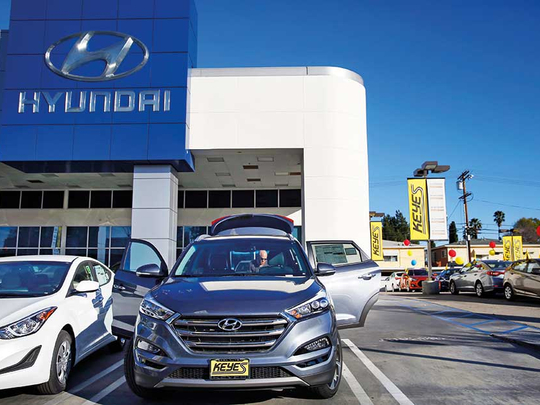
New York: Andrew DiFeo can remember a time, just four years ago, when he could hardly keep enough cars on the lot at his Hyundai dealership in Florida. Gasoline was selling for $3.50 or more a gallon, Americans were looking for good fuel economy, and Hyundai seemed to have the answer.
The feature-loaded Sonata sedan and the smaller Elantra were pulling buyers away from Toyota, Ford and other competitors. A shipment of Sonatas to DiFeo’s lot would be bought up in a week or two. Hyundai’s US market share hit an all-time high, about 5 per cent, and the company was setting its sights even higher.
“We had a lot of things going right in that time frame,” DiFeo said.
It is a far different story today. With gas prices lower, consumers have turned to roomier models like trucks and sport utility vehicles. Cars and compacts are less in demand — and Hyundai’s fortunes have fallen sharply.
Hyundai said sales in May had tumbled a surprising 15 per cent. After rising eight years in a row, overall sales at the company have fallen 4.8 per cent this year, and its share of the market declined to 4 per cent in May.
Overall, US auto sales in May fell 0.9 per cent, to 1.5 million cars and light trucks. It was the fifth consecutive monthly decline and further underscored that the US auto industry is slowing down after seven straight years of growth.
Michael J. O’Brien, Hyundai’s vice-president of corporate and product planning in the US, acknowledged that the company’s car-heavy model line was out of step with consumer tastes.
“We have work to do,” he said. “We are very well aware of where the market is.”
Hyundai attributed last month’s sales decline to a reduction in sales of cars to fleet customers like rental car companies. But sales of its Santa Fe SUV also slumped.
And in a clear sign of a soft sales market, the company is offering heavy discounts. Grappone Hyundai in Bow, New Hampshire, was advertising a fully loaded 2017 Sonata for $26,346 — more than $9,200 below its list price. Other models had discounts of $4,000 to $6,000, price cuts that would have been unimaginable five years ago.
“This seems to be resonating with the public,” said Larry Haynes, president of the Grappone Automotive Group. “It’s definitely helping us.”
Some of the discounts are aimed at helping dealers with an unusual problem: A number of 2016 models remain unsold in dealer inventories. DiFeo’s franchise still has six.
The price-cutting is taking a toll, though. The company blamed sales incentives in the US for a sharp drop in earnings in the fourth quarter of 2016 and cited them as a factor when it reported another decline in the first quarter of this year.
The US consumer’s swing toward bigger vehicles is one of the biggest changes automakers have seen in decades. Just four years ago, vehicles classified as light trucks, which include SUVs and most crossovers, made up half the US market. In the first five months of this year, 62 per cent of all new vehicles sold were from the category.
The trend is roiling big parts of the industry. Fiat Chrysler Automobiles stopped making small and mid-size cars last year and is converting two idled car plants to make Jeeps and trucks. A year ago, Ford Motor announced it would build a new small-car plant in Mexico, then cancelled the plan in January.
Hyundai has taken hits in two ways. The company’s affiliate, Kia, also relies on small and mid-size cars for most of its sales. So far this year, Kia’s sales in the US have fallen 9.8 per cent. Hyundai owns a large stake in Kia.
Hyundai’s troubles may also linger for some time.
Other automakers caught flat-footed by the shift have spent the past few years adding more SUVs, especially the lighter crossovers. Volkswagen, for example, has long relied on sales of its Jetta and Passat sedans.
But it added a redesigned Tiguan SUV last year, is rolling out a hulking model called the Atlas this year and has a compact crossover coming next year.
In contrast, Hyundai has invested in the wrong direction. The new models it is now rolling out include two luxury sedans sold under the Genesis brand name; the Ioniq, a hybrid compact; and a redesign of the mid-size Sonata, due next year.
All are in segments whose sales are declining. In the first three months of the year, luxury car sales fell 12 per cent, according to the researcher Autodata. Sales of mid-size sedans like the Sonata fell 17 per cent.
The new cars will sell well, O’Brien said. “At the end of the day, there’s still plenty of volume in the sedan area,” he said. He added that the company was working to increase production of its existing SUVs — the Tucson, Santa Fe and Santa Fe Sport.
It typically costs about $1 billion to develop a car from the ground up. The Ioniq was designed to compete with the top-selling hybrid, the Toyota Prius.
A new small SUV, the Kona, should arrive next year, followed by a redesign of the Santa Fe Sport then and a new large SUV.
“I think those vehicles will really make an impact,” he said. “Right now, we just have to stay focused until we get to that point.”
— New York Times News Service












